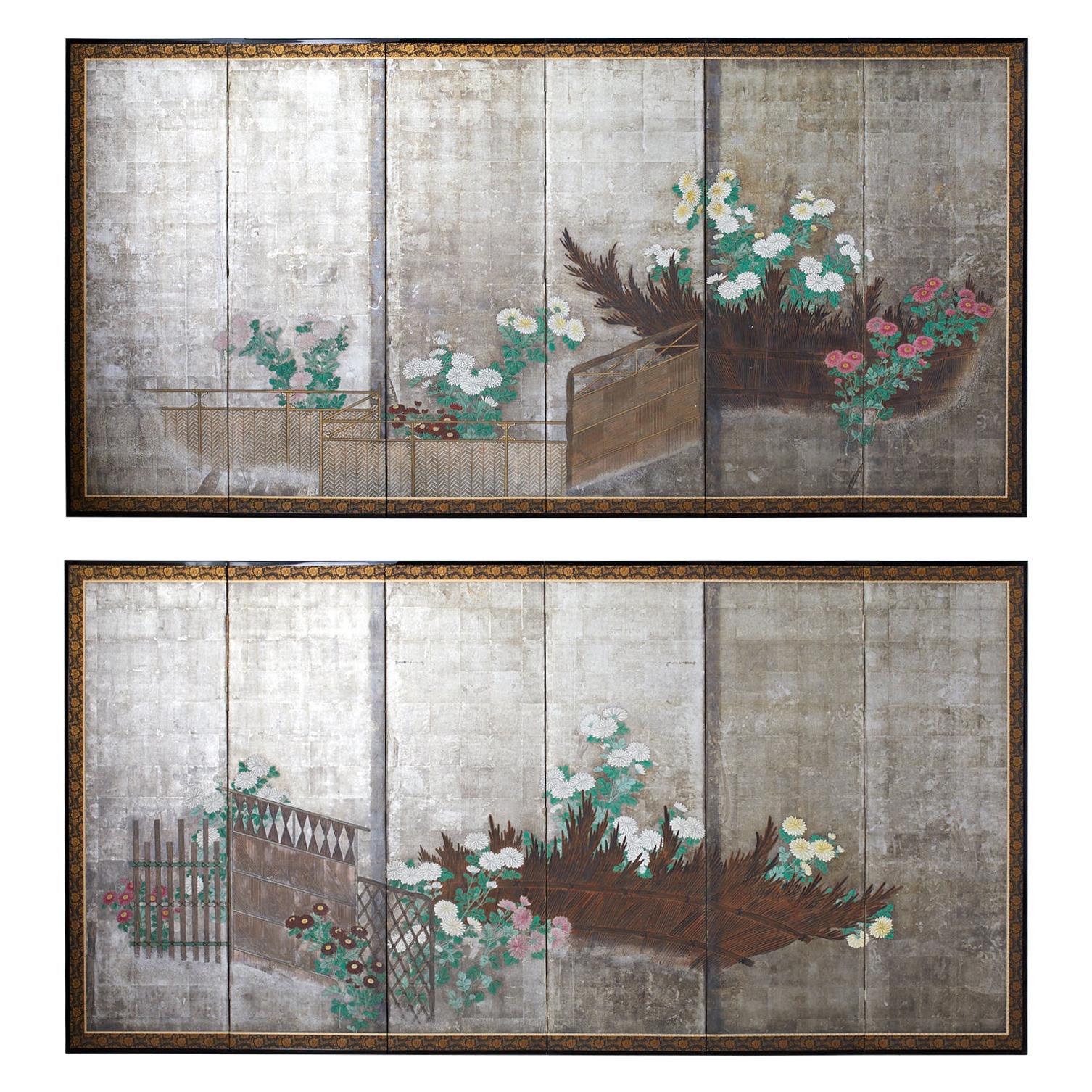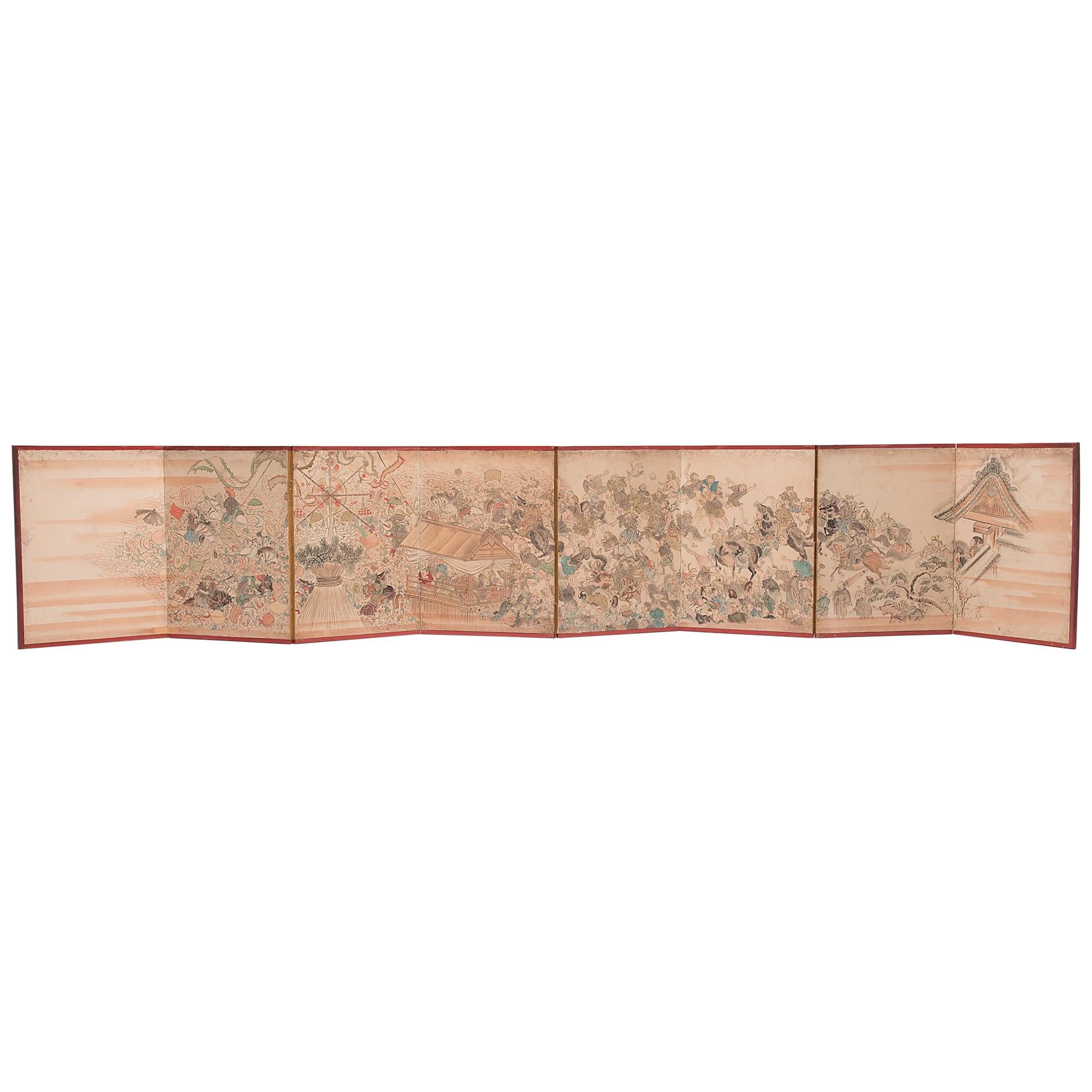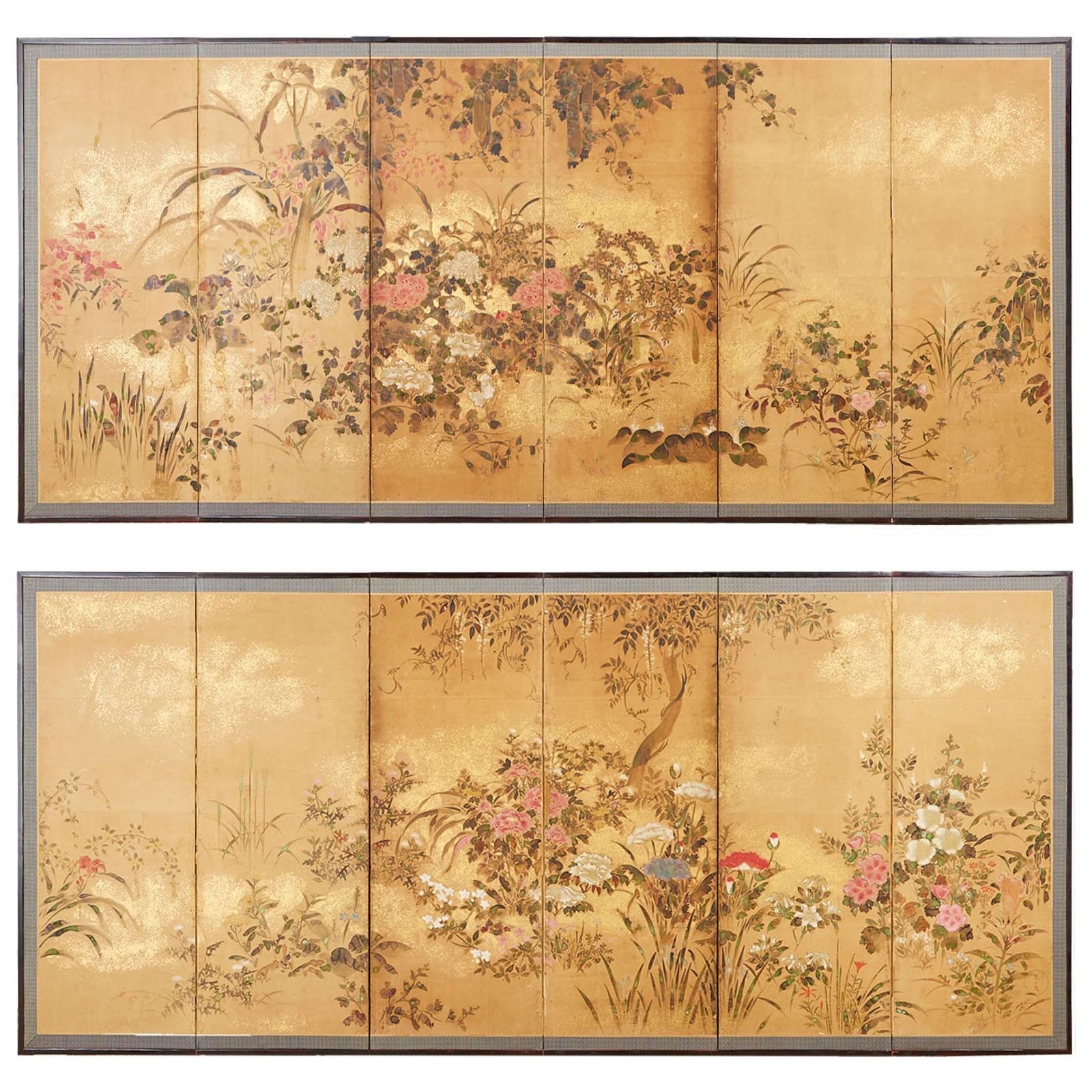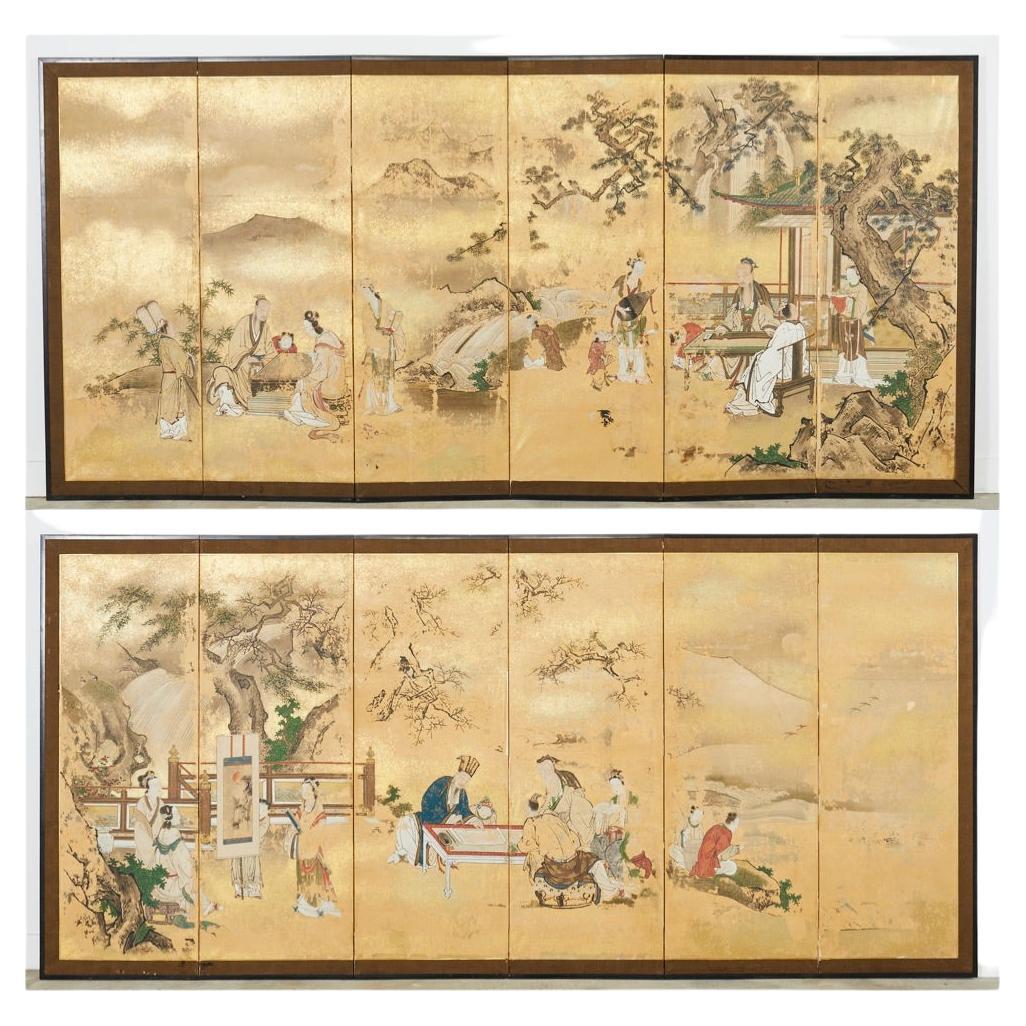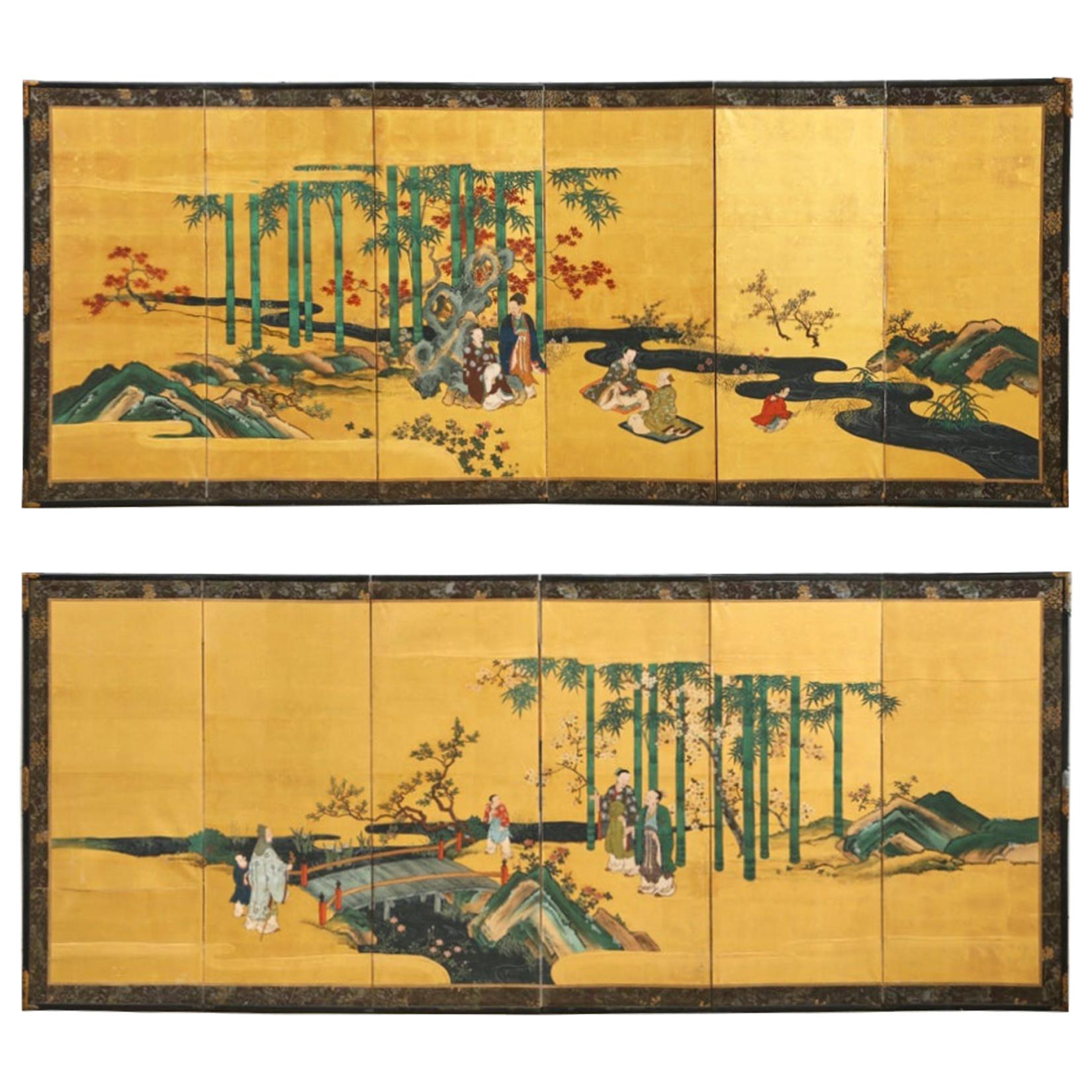Items Similar to Pair of Japanese Edo Screens Minogame Turtles in Spring Landscape
Video Loading
Want more images or videos?
Request additional images or videos from the seller
1 of 22
Pair of Japanese Edo Screens Minogame Turtles in Spring Landscape
About the Item
Colorful pair of 19th century Japanese Edo period six-panel byobu table screens depicting pairs of Minogame turtles in spring landscapes. Made in the Kano school style one screen features pines, willow, and flowering cherry trees. The other screen features pine, prunus, and flowering camelia. The paintings have an aged patina, but no rips or tears on the front images. Lovely example of Kano school artwork and depictions with turtles symbolizing longevity and good fortune. From an estate in Beverly Hills, CA. Price is for a pair.
- Dimensions:Height: 21.5 in (54.61 cm)Width: 61.5 in (156.21 cm)Depth: 0.5 in (1.27 cm)
- Sold As:Set of 2
- Style:Edo (Of the Period)
- Materials and Techniques:
- Place of Origin:
- Period:
- Date of Manufacture:19th Century
- Condition:Wear consistent with age and use. Beautifully painted with age appropriate wear and fading. No rips or tears on the painted panels only stains and foxing as seen in photos. Aged patina with losses on back sides as expected.
- Seller Location:Rio Vista, CA
- Reference Number:1stDibs: LU1555235537612

About the Seller
5.0
Erin Lane Estate is based in the San Francisco Bay Area, and its team of furniture restorers, art curators, professional appraisers and Asia specialists sources prime vintage and antique furniture from the finest estates in Northern and Southern California. Erin Lane Estate specializes in Hollywood Regency, McGuire, Chinese and Japanese pieces.
Diamond Seller
These expertly vetted sellers are 1stDibs' most experienced sellers and are rated highest by our customers.
Established in 2000
1stDibs seller since 2015
2,646 sales on 1stDibs
Typical response time: 1 hour
- ShippingRetrieving quote...Ships From: Rio Vista, CA
- Return PolicyA return for this item may be initiated within 1 day of delivery.
More From This SellerView All
- Pair of Japanese Edo Screens Chrysanthemums Along FenceLocated in Rio Vista, CARemarkable pair of early 19th century Japanese late Edo period screens depicting summer chrysanthemums growing along a brushwood fence. Ink and...Category
Antique 19th Century Japanese Edo Paintings and Screens
MaterialsSilver Leaf
- Pair of Japanese Edo Rimpa School Screens after Tawaraya SotatsuLocated in Rio Vista, CAImpressive pair of 17th century Japanese Edo period Rinpa school screens made in the manner and style of Autumn Grasses by Tawaraya Sotatsu (1570-1640). Beautifully decorated with wi...Category
Antique 17th Century Japanese Edo Paintings and Screens
MaterialsGold Leaf
- Pair of Japanese Edo Six Panel Screens Attributed Kano ToshunLocated in Rio Vista, CAIntriguing pair of 18th century Japanese Edo period six-panel screens of the four accomplishments attributed to Kano Toshun (1747-1797). The colorful Kano school screens are each sig...Category
Antique 18th Century Japanese Edo Paintings and Screens
MaterialsSilk, Wood, Paper
- Pair of Japanese Edo Six Panel Screens the Seven SagesLocated in Rio Vista, CAFantastic pair of 19th century Japanese late Edo/early Meiji period six-panel screens titled The seven sages of the bamboo grove. The Kano school screens...Category
Antique 19th Century Japanese Edo Paintings and Screens
MaterialsBrass, Gold Leaf
- Japanese Edo Two-Panel Screen Flowers of AutumnLocated in Rio Vista, CAImpressive early 19th century Japanese Edo period two-panel screen featuring flowering plants and grasses of autumn. Painted in the Tosa School style Bunka Bunsei period or Ogosho pe...Category
Antique 19th Century Japanese Edo Paintings and Screens
MaterialsSilk, Wood, Paper
- 19th Century Japanese Edo Six Panel Kano School Landscape ScreenLocated in Rio Vista, CALate Edo period 19th century Japanese six-panel landscape screen featuring a cypress tree over a flowering hibiscus with a pair of hototogisu birds. Kano school painted with ink and ...Category
Antique 19th Century Japanese Edo Paintings and Screens
MaterialsSilk, Wood, Paper
You May Also Like
- Edo Landscape Japanese Folding ScreenBy Japanese StudioLocated in Brescia, ITRefined work by a painter from the first half of the 19th century, from the landscape of the "Rinpa" school by a painter from the end of the 18th century, the Rinpa school. Six panels painted in ink on gold leaf and "gofun" on vegetable paper. The flowers are made with the "gofun" technique, natural or pigmented white oyster powder. Rinpa is one of the major historical schools of Japanese painting. The style was consolidated by the brothers Ogata Korin (1658–1716) and Ogata Kenzan (1663–1743). This folding screen has a very clean design that leaves plenty of room for the beautiful golden landscape. It comes flat and you can easily hang it with our hooks. Lucio Morini...Category
Antique 18th Century Japanese Edo Paintings and Screens
MaterialsGold Leaf
- Japanese Edo Festival Screen, c. 1750Located in Chicago, ILThis 18th century folding screen is a stunning example of Japanese artistry. Beautifully painted with delicate brushwork, the evocative screen depicts a lively festival during the Ed...Category
Antique Mid-18th Century Japanese Edo Paintings and Screens
MaterialsPaper
- Japanese Edo Period Two-Panel ScreenLocated in Stamford, CTA Japanese Edo Period two panel folding screen with white and brown hawks of ink and color on paper.Category
Antique Mid-19th Century Japanese Edo Paintings and Screens
MaterialsPaper
- Edo, Japanese Screen Two Panels Rinpa SchoolBy Japanese StudioLocated in Brescia, ITLandscape with Flowers and Bamboo by an 18th century painter of the Rinpa school, two panels painted in ink on gold leaf and vegetable paper. The flowers...Category
Antique 18th Century Japanese Edo Paintings and Screens
MaterialsGold Leaf
- Pair of Japanese Edo Period Six-Panel Screen, "100 Boys at Play"Located in Austin, TXAn absolutely charming pair of Japanese Tosa School six-panel folding screens painted with the "One Hundred Boys at Play" motif, featuring a multitude...Category
Antique Early 19th Century Japanese Edo Paintings and Screens
MaterialsGold Leaf
- Japanese Screen Pair, Tigers by Kishi Renzan, Late Edo PeriodLocated in Kyoto, JPKishi Renzan (1804-1859) Tigers Pair of six-panel Japanese screens. Ink and gold-leaf on paper. In this monochromatic pair of six-fold Japanese screens painted on gold-leaf, Kishi Renzan has created a breathtaking composition of a family of tigers. The screens are filled with a sense of drama which is conveyed by both the subject matter and the wet, expressive brushwork. The running mountain stream and the towering waterfall allude to refreshment during the summer months and we feel the tiger families familiarity and security within their environment. Renzan’s master, Kishi Ganku...Category
Antique Mid-19th Century Asian Edo Paintings and Screens
MaterialsGold Leaf
Recently Viewed
View AllMore Ways To Browse
Lotus In Pichwai
Peacock Turtle
Asian 6 Panel Coromandel
Genji Screen
Chinese Export Coromandel
Gold Screen
Sakura Screen
Chinoiserie Panel Painting
Antique Korean Screens
Manjushri Thangka Of Wisdom
Qiu Yu
Chinese Hardwood Screens
Black And Gold Chinese Screen
Chinese Screen 17th Century
Black Coromandel Screen
Chinese Antique Gold Screen
Coromandel Black Lacquer Screen
Red Coromandel Panels

